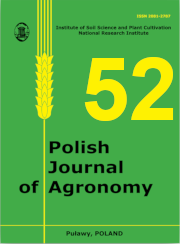Effects of different variants of basalt-sulphur improver in the fertilisation of spring oilseed rape
Main Article Content
Abstract
The aim of the research was to test of several variants of basalt-sulphur improver, differing in the ratio of the two components, and to select the most suitable one for oil seed rape. Basalt dust, which is a troublesome by-product of rock processing,and elemental sulphur were used to produce the improver. The study included 3 improver variants with 1, 1.5 and 2% S and a control treatment without an improver. The experiment was conducted in concreted microplots filled with two soils: sandy loam and loamy sand, in a split-block two-factor design, in 4 replicates. The most suitable variant for rapeseed was the variant containing 1.5% S, which resulted in a 12% increase in rapeseedyield on sandy loam. Moreover, for this variant, an increasein seed fat content, an increase in the bioavailable form of sulphurin the soil and an increase in the concentration of this nutrient inoilseed rape straw and seed were observed on both soils.
Article Details

This work is licensed under a Creative Commons Attribution-ShareAlike 4.0 International License.
The author grants the editorial staff of the Polish Journal of Agronomy (abbreviated as PJA) a non-exclusive and royalty-free license to use the author's copyright in the paper/printed and electronic versions of his/her work published in PJA in Poland and abroad, in whole or in any part, including placing the work in electronic databases/databases locally or available on the Internet, for an unlimited period of time in the fields of exploitation specified in article 50 of the Copyright and Related Rights Act.
Manuscripts published in Polish Journal of Agronomy are available under a Creative Commons Attribution-ShareAlike 4.0 (CC-BY-SA) license.

